HLSC122 Assessment 3: Critical Appraisal of Drug Use Research
VerifiedAdded on 2023/01/18
|8
|1974
|48
Report
AI Summary
This report provides a critical appraisal of the research article by Day et al. (2018) on drug use, knowledge, and practices among music festival attendees. The analysis assesses the authorship, research questions, design, methods, and results, including limitations. The study, conducted at an Australi...
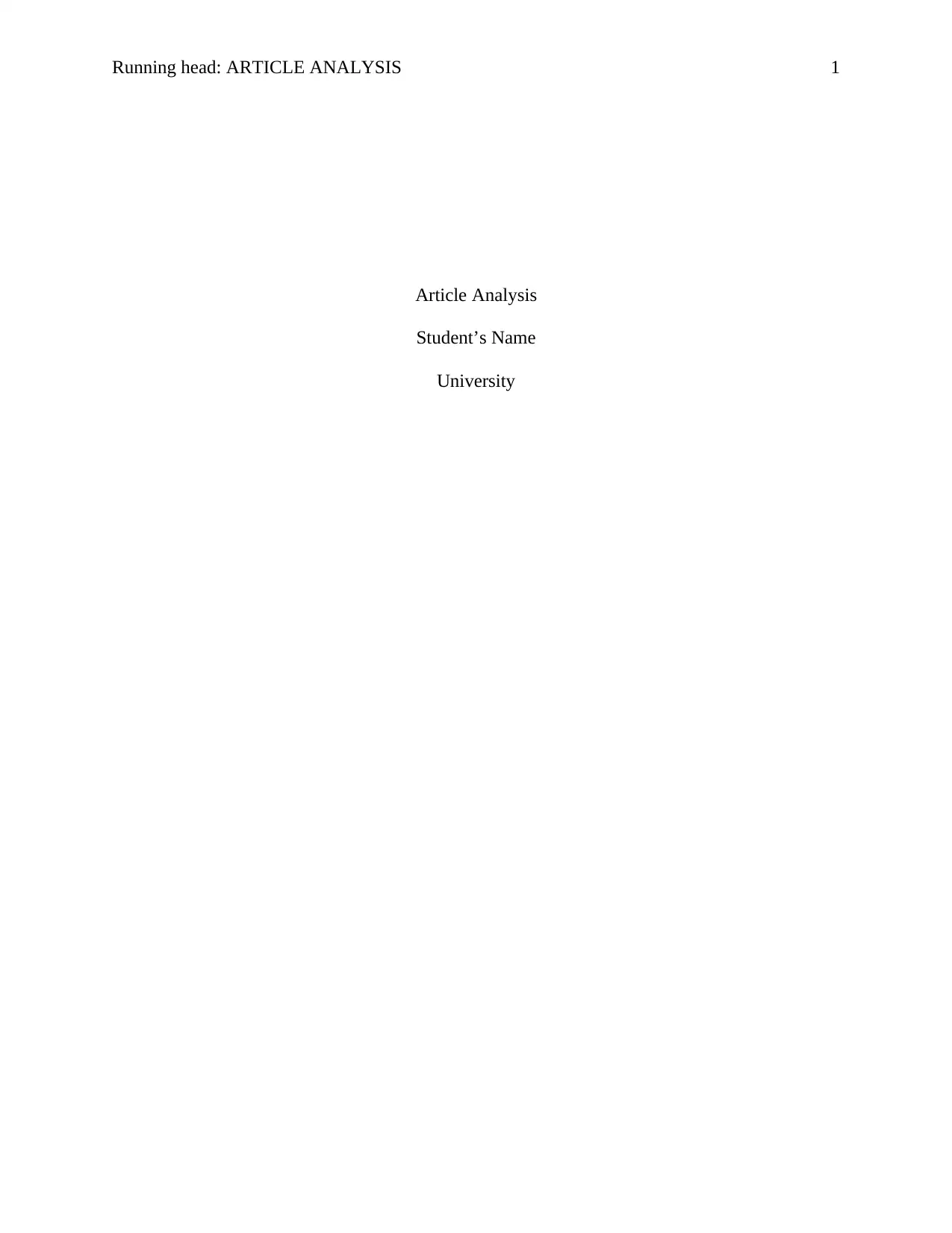
Running head: ARTICLE ANALYSIS 1
Article Analysis
Student’s Name
University
Article Analysis
Student’s Name
University
Paraphrase This Document
Need a fresh take? Get an instant paraphrase of this document with our AI Paraphraser
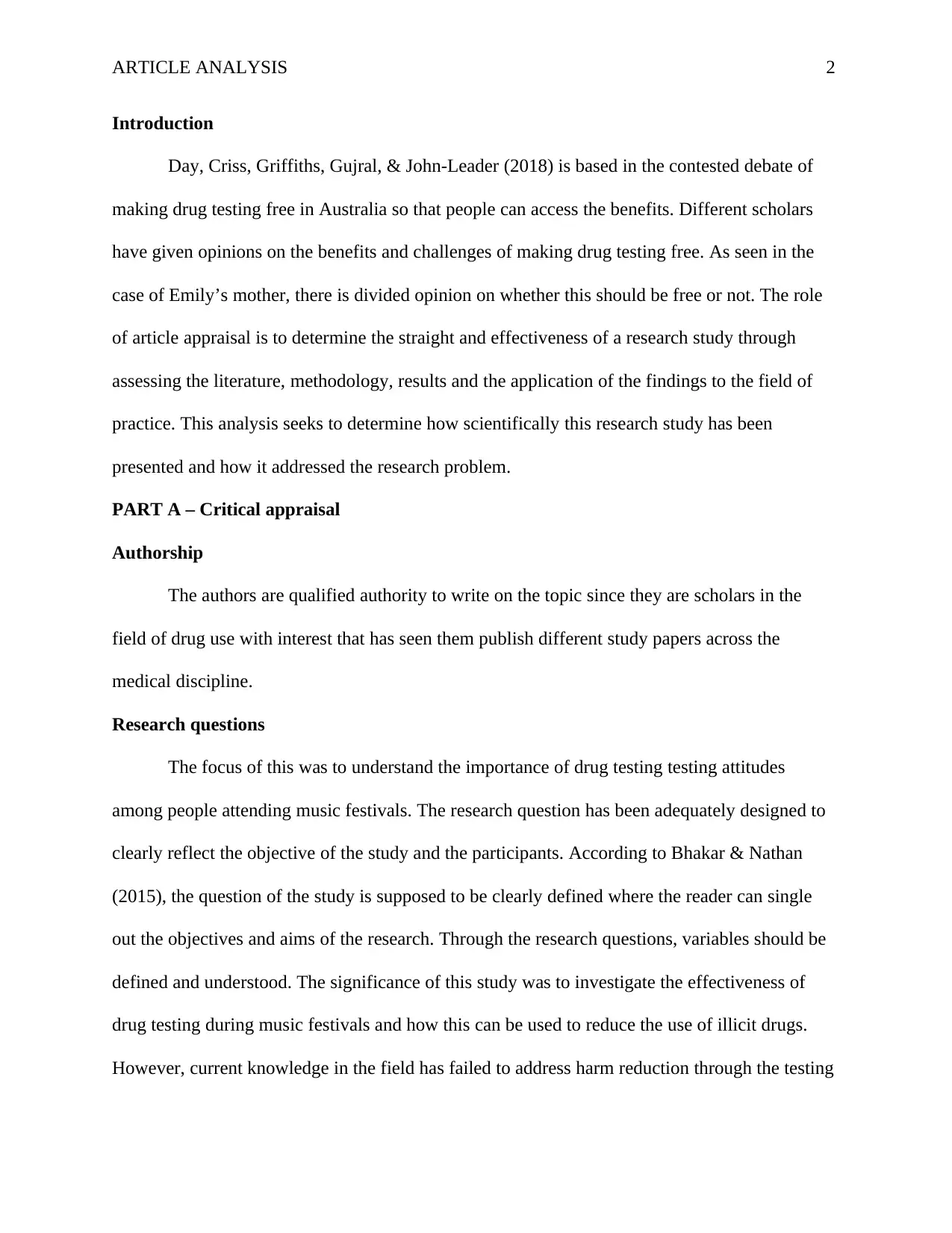
ARTICLE ANALYSIS 2
Introduction
Day, Criss, Griffiths, Gujral, & John-Leader (2018) is based in the contested debate of
making drug testing free in Australia so that people can access the benefits. Different scholars
have given opinions on the benefits and challenges of making drug testing free. As seen in the
case of Emily’s mother, there is divided opinion on whether this should be free or not. The role
of article appraisal is to determine the straight and effectiveness of a research study through
assessing the literature, methodology, results and the application of the findings to the field of
practice. This analysis seeks to determine how scientifically this research study has been
presented and how it addressed the research problem.
PART A – Critical appraisal
Authorship
The authors are qualified authority to write on the topic since they are scholars in the
field of drug use with interest that has seen them publish different study papers across the
medical discipline.
Research questions
The focus of this was to understand the importance of drug testing testing attitudes
among people attending music festivals. The research question has been adequately designed to
clearly reflect the objective of the study and the participants. According to Bhakar & Nathan
(2015), the question of the study is supposed to be clearly defined where the reader can single
out the objectives and aims of the research. Through the research questions, variables should be
defined and understood. The significance of this study was to investigate the effectiveness of
drug testing during music festivals and how this can be used to reduce the use of illicit drugs.
However, current knowledge in the field has failed to address harm reduction through the testing
Introduction
Day, Criss, Griffiths, Gujral, & John-Leader (2018) is based in the contested debate of
making drug testing free in Australia so that people can access the benefits. Different scholars
have given opinions on the benefits and challenges of making drug testing free. As seen in the
case of Emily’s mother, there is divided opinion on whether this should be free or not. The role
of article appraisal is to determine the straight and effectiveness of a research study through
assessing the literature, methodology, results and the application of the findings to the field of
practice. This analysis seeks to determine how scientifically this research study has been
presented and how it addressed the research problem.
PART A – Critical appraisal
Authorship
The authors are qualified authority to write on the topic since they are scholars in the
field of drug use with interest that has seen them publish different study papers across the
medical discipline.
Research questions
The focus of this was to understand the importance of drug testing testing attitudes
among people attending music festivals. The research question has been adequately designed to
clearly reflect the objective of the study and the participants. According to Bhakar & Nathan
(2015), the question of the study is supposed to be clearly defined where the reader can single
out the objectives and aims of the research. Through the research questions, variables should be
defined and understood. The significance of this study was to investigate the effectiveness of
drug testing during music festivals and how this can be used to reduce the use of illicit drugs.
However, current knowledge in the field has failed to address harm reduction through the testing
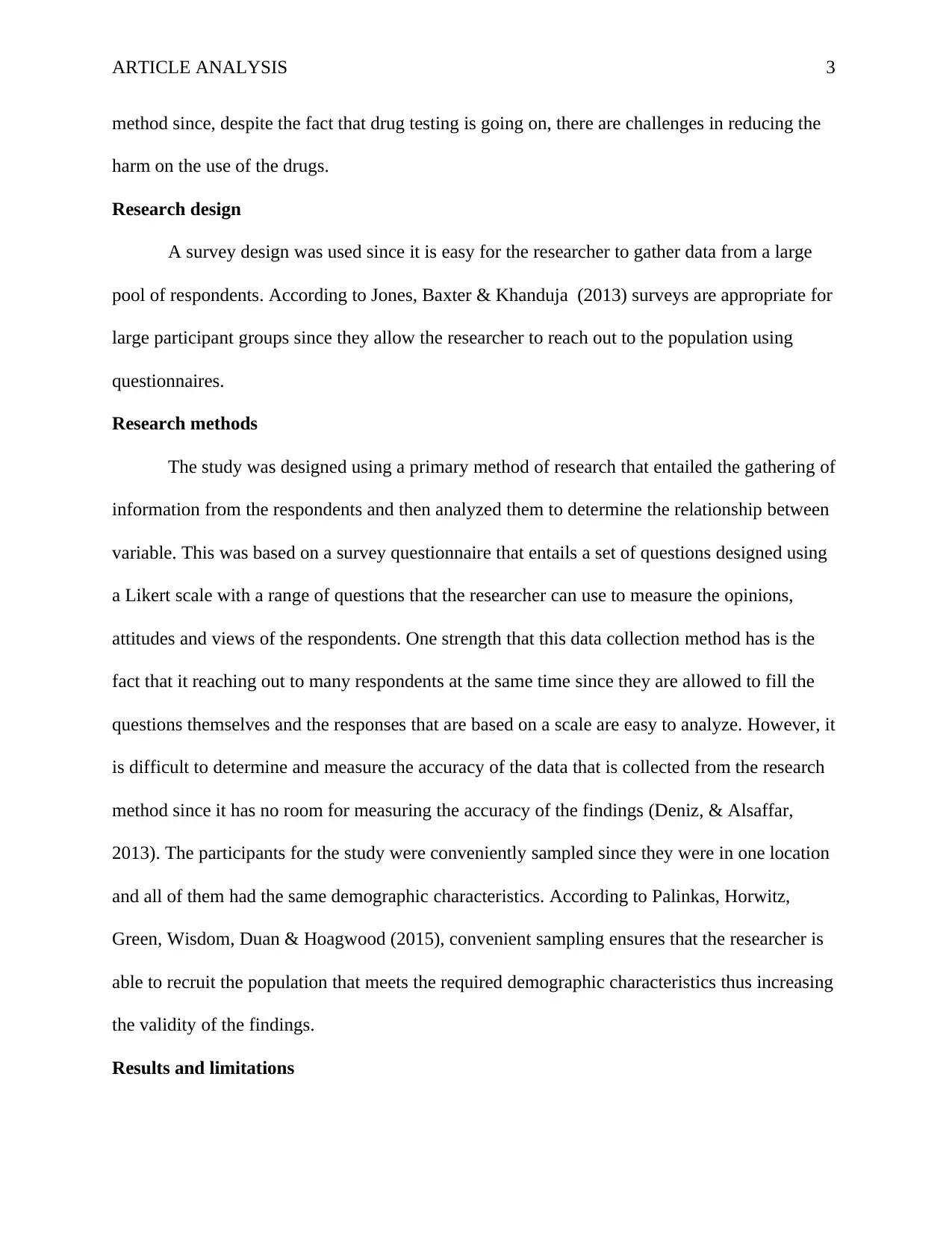
ARTICLE ANALYSIS 3
method since, despite the fact that drug testing is going on, there are challenges in reducing the
harm on the use of the drugs.
Research design
A survey design was used since it is easy for the researcher to gather data from a large
pool of respondents. According to Jones, Baxter & Khanduja (2013) surveys are appropriate for
large participant groups since they allow the researcher to reach out to the population using
questionnaires.
Research methods
The study was designed using a primary method of research that entailed the gathering of
information from the respondents and then analyzed them to determine the relationship between
variable. This was based on a survey questionnaire that entails a set of questions designed using
a Likert scale with a range of questions that the researcher can use to measure the opinions,
attitudes and views of the respondents. One strength that this data collection method has is the
fact that it reaching out to many respondents at the same time since they are allowed to fill the
questions themselves and the responses that are based on a scale are easy to analyze. However, it
is difficult to determine and measure the accuracy of the data that is collected from the research
method since it has no room for measuring the accuracy of the findings (Deniz, & Alsaffar,
2013). The participants for the study were conveniently sampled since they were in one location
and all of them had the same demographic characteristics. According to Palinkas, Horwitz,
Green, Wisdom, Duan & Hoagwood (2015), convenient sampling ensures that the researcher is
able to recruit the population that meets the required demographic characteristics thus increasing
the validity of the findings.
Results and limitations
method since, despite the fact that drug testing is going on, there are challenges in reducing the
harm on the use of the drugs.
Research design
A survey design was used since it is easy for the researcher to gather data from a large
pool of respondents. According to Jones, Baxter & Khanduja (2013) surveys are appropriate for
large participant groups since they allow the researcher to reach out to the population using
questionnaires.
Research methods
The study was designed using a primary method of research that entailed the gathering of
information from the respondents and then analyzed them to determine the relationship between
variable. This was based on a survey questionnaire that entails a set of questions designed using
a Likert scale with a range of questions that the researcher can use to measure the opinions,
attitudes and views of the respondents. One strength that this data collection method has is the
fact that it reaching out to many respondents at the same time since they are allowed to fill the
questions themselves and the responses that are based on a scale are easy to analyze. However, it
is difficult to determine and measure the accuracy of the data that is collected from the research
method since it has no room for measuring the accuracy of the findings (Deniz, & Alsaffar,
2013). The participants for the study were conveniently sampled since they were in one location
and all of them had the same demographic characteristics. According to Palinkas, Horwitz,
Green, Wisdom, Duan & Hoagwood (2015), convenient sampling ensures that the researcher is
able to recruit the population that meets the required demographic characteristics thus increasing
the validity of the findings.
Results and limitations
⊘ This is a preview!⊘
Do you want full access?
Subscribe today to unlock all pages.

Trusted by 1+ million students worldwide

ARTICLE ANALYSIS 4
From the results 73.8% of the participants had used drugs in their life while alcohol was
the most used drug at 97.8%. Further, it was reported that within the last 12 months, several
drugs had been used by the participants at different levels. These drugs are cannabis, ecstasy, and
cocaine while the level of use was reported as 63.9, 59.8 and 34.1%, respectively. Also, the
majority of the participants agreed that it was good to make drug testing available with 86.5% of
the respondents asserting that this can reduce the harm of consuming these drugs from
participants. However, the male participant (73.5%) were more resistant to free provision of drug
testing services while the majority of the females (64.0%) felt that drug testing should be
provided at no cost.
This study was limited by the fact that it used convenience sampling which makes it
difficult to generalize the findings. The fact that the participants were from the same
demographic characteristics like age and location or settings challenges the validity of the
results. According to Megan, Ranney, Garro, Sasson & Morrow (2016), an appropriate sample is
the one that represents the demographic diversity of the population that it represents to increase
the validity of the results.
PART B – Application of evidence to practice
The role of research is to gather information and present findings that can be linked to
previous studies by adding weight to the existing knowledge. This study strength is based on the
fact that it shows the majority of the participants believed that drug testing can be important in
reducing the harm of illicit drugs. By testing the drugs and making the results harm reduction is
increased since most young people will avoid the drugs that have been described a lethal or not
fit for use. Since the findings of this showed that majority of the respondents had used at least
one type of drug in their lifetime, then it means that there is a need to find ways of ensuring that
From the results 73.8% of the participants had used drugs in their life while alcohol was
the most used drug at 97.8%. Further, it was reported that within the last 12 months, several
drugs had been used by the participants at different levels. These drugs are cannabis, ecstasy, and
cocaine while the level of use was reported as 63.9, 59.8 and 34.1%, respectively. Also, the
majority of the participants agreed that it was good to make drug testing available with 86.5% of
the respondents asserting that this can reduce the harm of consuming these drugs from
participants. However, the male participant (73.5%) were more resistant to free provision of drug
testing services while the majority of the females (64.0%) felt that drug testing should be
provided at no cost.
This study was limited by the fact that it used convenience sampling which makes it
difficult to generalize the findings. The fact that the participants were from the same
demographic characteristics like age and location or settings challenges the validity of the
results. According to Megan, Ranney, Garro, Sasson & Morrow (2016), an appropriate sample is
the one that represents the demographic diversity of the population that it represents to increase
the validity of the results.
PART B – Application of evidence to practice
The role of research is to gather information and present findings that can be linked to
previous studies by adding weight to the existing knowledge. This study strength is based on the
fact that it shows the majority of the participants believed that drug testing can be important in
reducing the harm of illicit drugs. By testing the drugs and making the results harm reduction is
increased since most young people will avoid the drugs that have been described a lethal or not
fit for use. Since the findings of this showed that majority of the respondents had used at least
one type of drug in their lifetime, then it means that there is a need to find ways of ensuring that
Paraphrase This Document
Need a fresh take? Get an instant paraphrase of this document with our AI Paraphraser
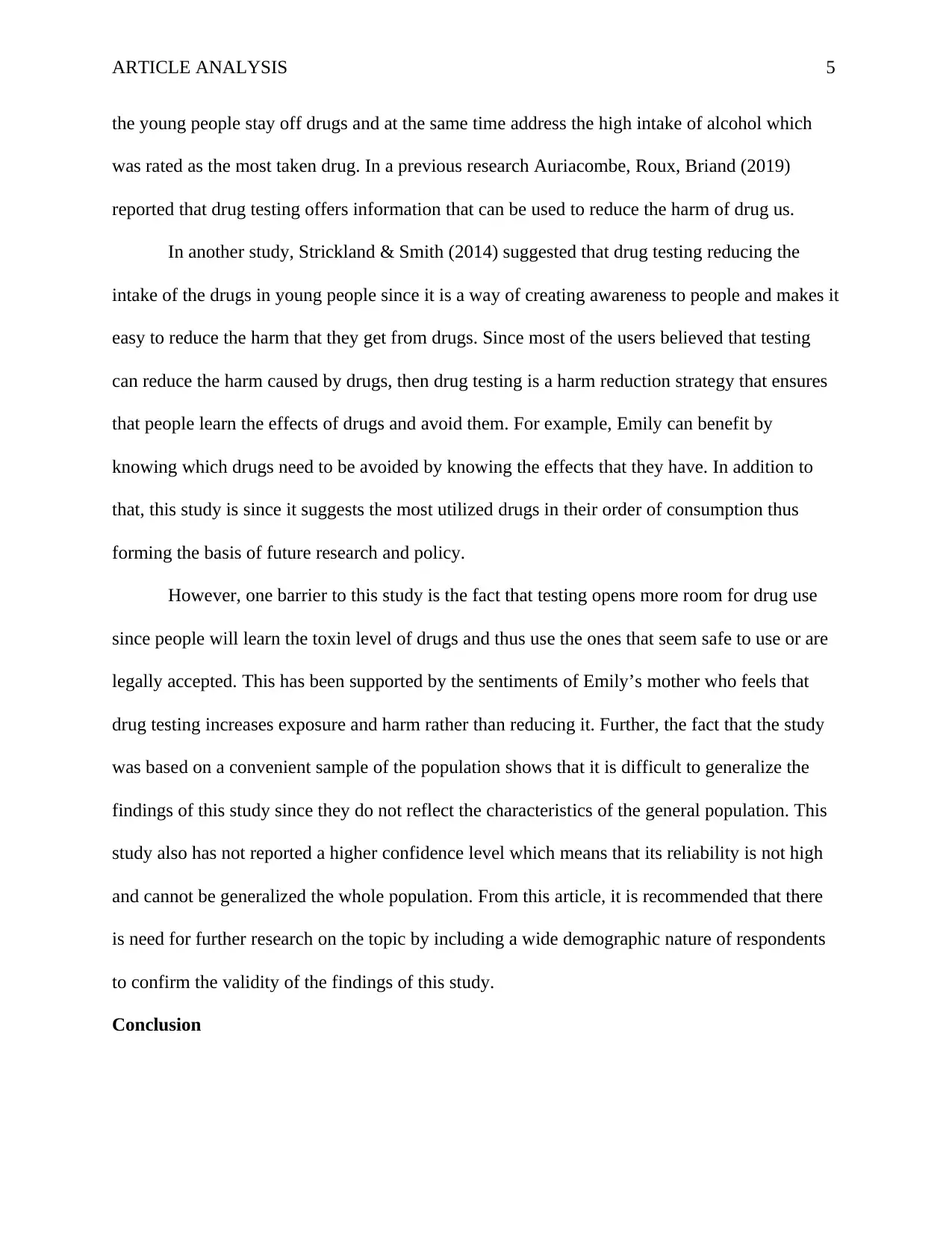
ARTICLE ANALYSIS 5
the young people stay off drugs and at the same time address the high intake of alcohol which
was rated as the most taken drug. In a previous research Auriacombe, Roux, Briand (2019)
reported that drug testing offers information that can be used to reduce the harm of drug us.
In another study, Strickland & Smith (2014) suggested that drug testing reducing the
intake of the drugs in young people since it is a way of creating awareness to people and makes it
easy to reduce the harm that they get from drugs. Since most of the users believed that testing
can reduce the harm caused by drugs, then drug testing is a harm reduction strategy that ensures
that people learn the effects of drugs and avoid them. For example, Emily can benefit by
knowing which drugs need to be avoided by knowing the effects that they have. In addition to
that, this study is since it suggests the most utilized drugs in their order of consumption thus
forming the basis of future research and policy.
However, one barrier to this study is the fact that testing opens more room for drug use
since people will learn the toxin level of drugs and thus use the ones that seem safe to use or are
legally accepted. This has been supported by the sentiments of Emily’s mother who feels that
drug testing increases exposure and harm rather than reducing it. Further, the fact that the study
was based on a convenient sample of the population shows that it is difficult to generalize the
findings of this study since they do not reflect the characteristics of the general population. This
study also has not reported a higher confidence level which means that its reliability is not high
and cannot be generalized the whole population. From this article, it is recommended that there
is need for further research on the topic by including a wide demographic nature of respondents
to confirm the validity of the findings of this study.
Conclusion
the young people stay off drugs and at the same time address the high intake of alcohol which
was rated as the most taken drug. In a previous research Auriacombe, Roux, Briand (2019)
reported that drug testing offers information that can be used to reduce the harm of drug us.
In another study, Strickland & Smith (2014) suggested that drug testing reducing the
intake of the drugs in young people since it is a way of creating awareness to people and makes it
easy to reduce the harm that they get from drugs. Since most of the users believed that testing
can reduce the harm caused by drugs, then drug testing is a harm reduction strategy that ensures
that people learn the effects of drugs and avoid them. For example, Emily can benefit by
knowing which drugs need to be avoided by knowing the effects that they have. In addition to
that, this study is since it suggests the most utilized drugs in their order of consumption thus
forming the basis of future research and policy.
However, one barrier to this study is the fact that testing opens more room for drug use
since people will learn the toxin level of drugs and thus use the ones that seem safe to use or are
legally accepted. This has been supported by the sentiments of Emily’s mother who feels that
drug testing increases exposure and harm rather than reducing it. Further, the fact that the study
was based on a convenient sample of the population shows that it is difficult to generalize the
findings of this study since they do not reflect the characteristics of the general population. This
study also has not reported a higher confidence level which means that its reliability is not high
and cannot be generalized the whole population. From this article, it is recommended that there
is need for further research on the topic by including a wide demographic nature of respondents
to confirm the validity of the findings of this study.
Conclusion
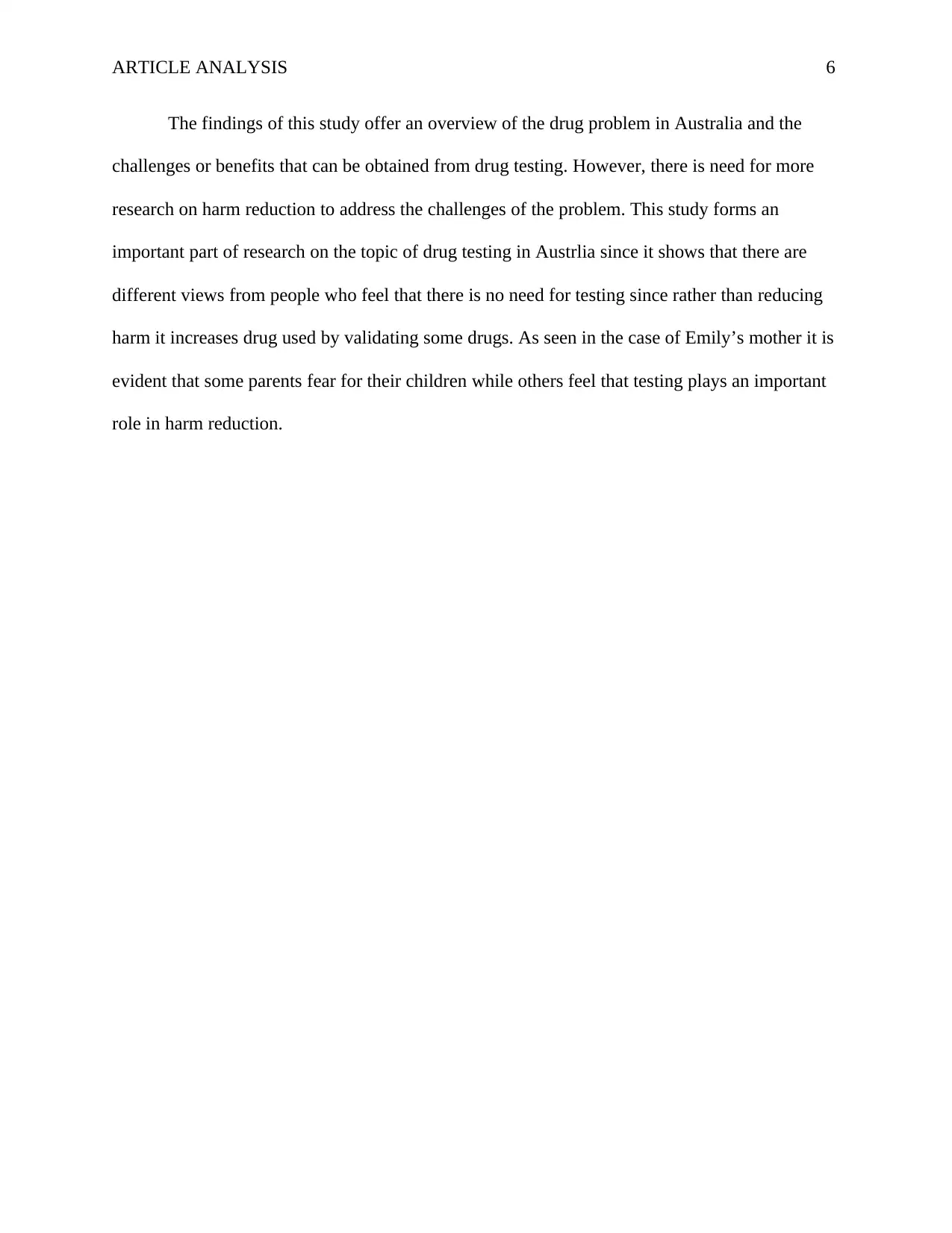
ARTICLE ANALYSIS 6
The findings of this study offer an overview of the drug problem in Australia and the
challenges or benefits that can be obtained from drug testing. However, there is need for more
research on harm reduction to address the challenges of the problem. This study forms an
important part of research on the topic of drug testing in Austrlia since it shows that there are
different views from people who feel that there is no need for testing since rather than reducing
harm it increases drug used by validating some drugs. As seen in the case of Emily’s mother it is
evident that some parents fear for their children while others feel that testing plays an important
role in harm reduction.
The findings of this study offer an overview of the drug problem in Australia and the
challenges or benefits that can be obtained from drug testing. However, there is need for more
research on harm reduction to address the challenges of the problem. This study forms an
important part of research on the topic of drug testing in Austrlia since it shows that there are
different views from people who feel that there is no need for testing since rather than reducing
harm it increases drug used by validating some drugs. As seen in the case of Emily’s mother it is
evident that some parents fear for their children while others feel that testing plays an important
role in harm reduction.
⊘ This is a preview!⊘
Do you want full access?
Subscribe today to unlock all pages.

Trusted by 1+ million students worldwide
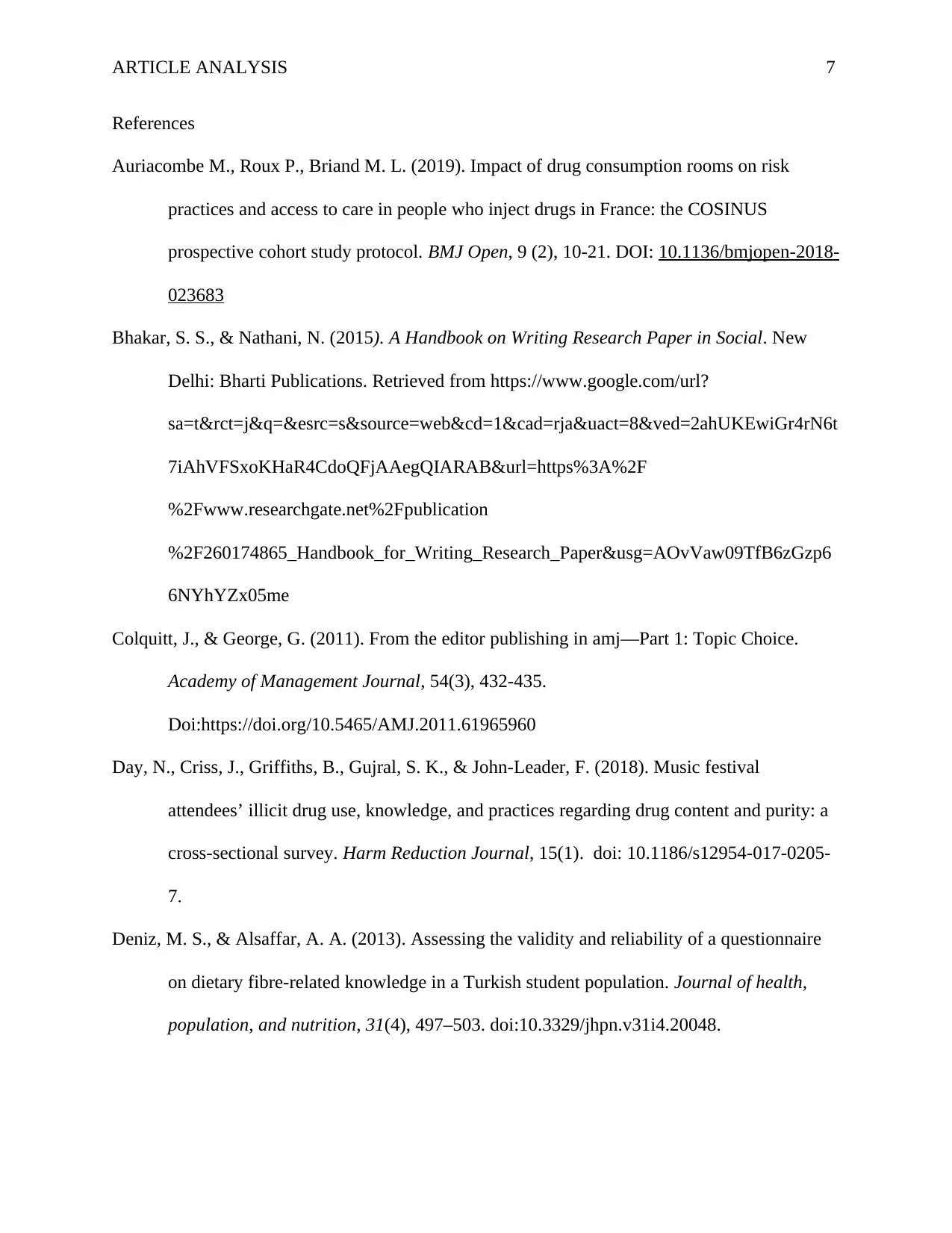
ARTICLE ANALYSIS 7
References
Auriacombe M., Roux P., Briand M. L. (2019). Impact of drug consumption rooms on risk
practices and access to care in people who inject drugs in France: the COSINUS
prospective cohort study protocol. BMJ Open, 9 (2), 10-21. DOI: 10.1136/bmjopen-2018-
023683
Bhakar, S. S., & Nathani, N. (2015). A Handbook on Writing Research Paper in Social. New
Delhi: Bharti Publications. Retrieved from https://www.google.com/url?
sa=t&rct=j&q=&esrc=s&source=web&cd=1&cad=rja&uact=8&ved=2ahUKEwiGr4rN6t
7iAhVFSxoKHaR4CdoQFjAAegQIARAB&url=https%3A%2F
%2Fwww.researchgate.net%2Fpublication
%2F260174865_Handbook_for_Writing_Research_Paper&usg=AOvVaw09TfB6zGzp6
6NYhYZx05me
Colquitt, J., & George, G. (2011). From the editor publishing in amj—Part 1: Topic Choice.
Academy of Management Journal, 54(3), 432-435.
Doi:https://doi.org/10.5465/AMJ.2011.61965960
Day, N., Criss, J., Griffiths, B., Gujral, S. K., & John-Leader, F. (2018). Music festival
attendees’ illicit drug use, knowledge, and practices regarding drug content and purity: a
cross-sectional survey. Harm Reduction Journal, 15(1). doi: 10.1186/s12954-017-0205-
7.
Deniz, M. S., & Alsaffar, A. A. (2013). Assessing the validity and reliability of a questionnaire
on dietary fibre-related knowledge in a Turkish student population. Journal of health,
population, and nutrition, 31(4), 497–503. doi:10.3329/jhpn.v31i4.20048.
References
Auriacombe M., Roux P., Briand M. L. (2019). Impact of drug consumption rooms on risk
practices and access to care in people who inject drugs in France: the COSINUS
prospective cohort study protocol. BMJ Open, 9 (2), 10-21. DOI: 10.1136/bmjopen-2018-
023683
Bhakar, S. S., & Nathani, N. (2015). A Handbook on Writing Research Paper in Social. New
Delhi: Bharti Publications. Retrieved from https://www.google.com/url?
sa=t&rct=j&q=&esrc=s&source=web&cd=1&cad=rja&uact=8&ved=2ahUKEwiGr4rN6t
7iAhVFSxoKHaR4CdoQFjAAegQIARAB&url=https%3A%2F
%2Fwww.researchgate.net%2Fpublication
%2F260174865_Handbook_for_Writing_Research_Paper&usg=AOvVaw09TfB6zGzp6
6NYhYZx05me
Colquitt, J., & George, G. (2011). From the editor publishing in amj—Part 1: Topic Choice.
Academy of Management Journal, 54(3), 432-435.
Doi:https://doi.org/10.5465/AMJ.2011.61965960
Day, N., Criss, J., Griffiths, B., Gujral, S. K., & John-Leader, F. (2018). Music festival
attendees’ illicit drug use, knowledge, and practices regarding drug content and purity: a
cross-sectional survey. Harm Reduction Journal, 15(1). doi: 10.1186/s12954-017-0205-
7.
Deniz, M. S., & Alsaffar, A. A. (2013). Assessing the validity and reliability of a questionnaire
on dietary fibre-related knowledge in a Turkish student population. Journal of health,
population, and nutrition, 31(4), 497–503. doi:10.3329/jhpn.v31i4.20048.
Paraphrase This Document
Need a fresh take? Get an instant paraphrase of this document with our AI Paraphraser
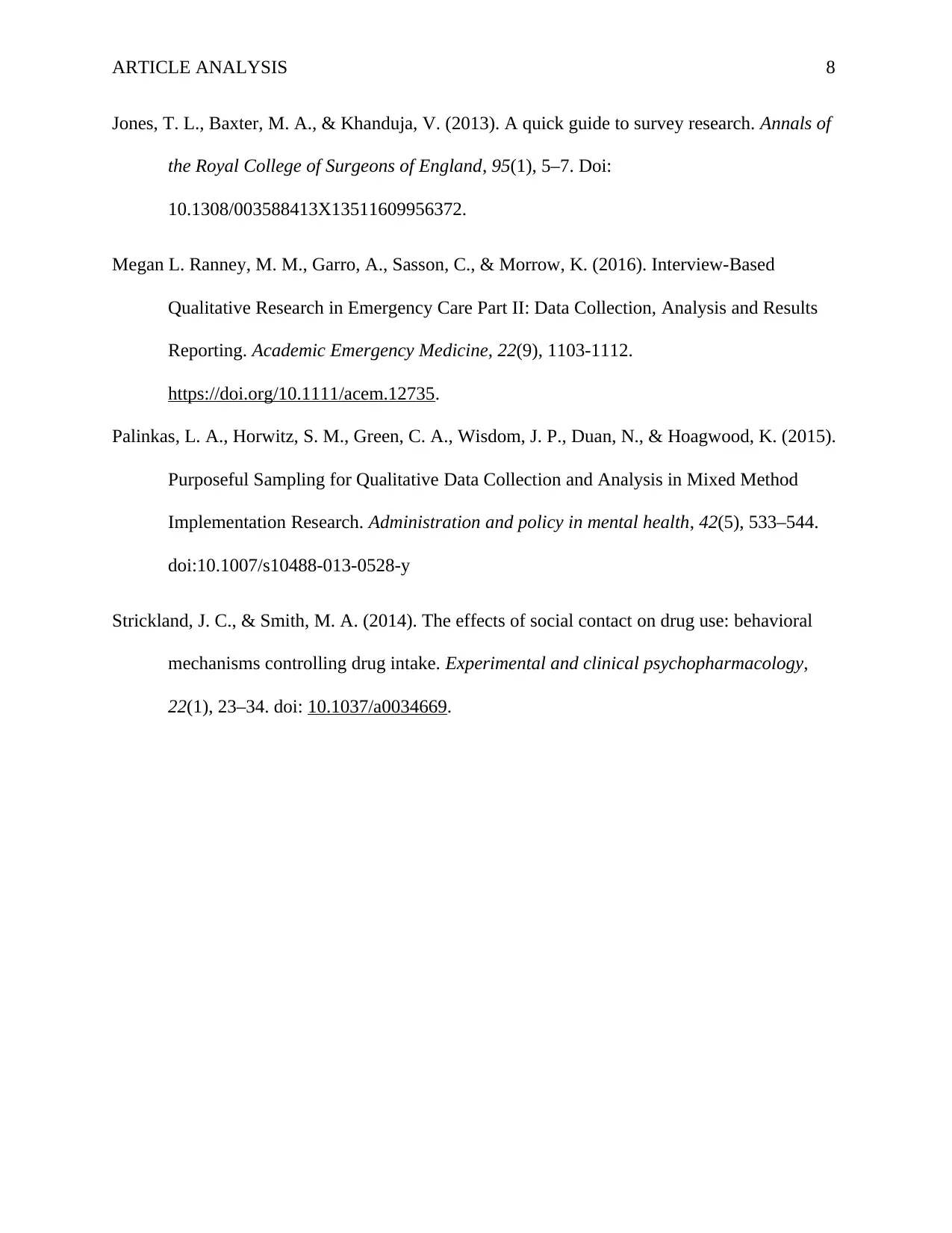
ARTICLE ANALYSIS 8
Jones, T. L., Baxter, M. A., & Khanduja, V. (2013). A quick guide to survey research. Annals of
the Royal College of Surgeons of England, 95(1), 5–7. Doi:
10.1308/003588413X13511609956372.
Megan L. Ranney, M. M., Garro, A., Sasson, C., & Morrow, K. (2016). Interview-Based
Qualitative Research in Emergency Care Part II: Data Collection, Analysis and Results
Reporting. Academic Emergency Medicine, 22(9), 1103-1112.
https://doi.org/10.1111/acem.12735.
Palinkas, L. A., Horwitz, S. M., Green, C. A., Wisdom, J. P., Duan, N., & Hoagwood, K. (2015).
Purposeful Sampling for Qualitative Data Collection and Analysis in Mixed Method
Implementation Research. Administration and policy in mental health, 42(5), 533–544.
doi:10.1007/s10488-013-0528-y
Strickland, J. C., & Smith, M. A. (2014). The effects of social contact on drug use: behavioral
mechanisms controlling drug intake. Experimental and clinical psychopharmacology,
22(1), 23–34. doi: 10.1037/a0034669.
Jones, T. L., Baxter, M. A., & Khanduja, V. (2013). A quick guide to survey research. Annals of
the Royal College of Surgeons of England, 95(1), 5–7. Doi:
10.1308/003588413X13511609956372.
Megan L. Ranney, M. M., Garro, A., Sasson, C., & Morrow, K. (2016). Interview-Based
Qualitative Research in Emergency Care Part II: Data Collection, Analysis and Results
Reporting. Academic Emergency Medicine, 22(9), 1103-1112.
https://doi.org/10.1111/acem.12735.
Palinkas, L. A., Horwitz, S. M., Green, C. A., Wisdom, J. P., Duan, N., & Hoagwood, K. (2015).
Purposeful Sampling for Qualitative Data Collection and Analysis in Mixed Method
Implementation Research. Administration and policy in mental health, 42(5), 533–544.
doi:10.1007/s10488-013-0528-y
Strickland, J. C., & Smith, M. A. (2014). The effects of social contact on drug use: behavioral
mechanisms controlling drug intake. Experimental and clinical psychopharmacology,
22(1), 23–34. doi: 10.1037/a0034669.
1 out of 8
Related Documents
Your All-in-One AI-Powered Toolkit for Academic Success.
+13062052269
info@desklib.com
Available 24*7 on WhatsApp / Email
![[object Object]](/_next/static/media/star-bottom.7253800d.svg)
Unlock your academic potential
© 2024 | Zucol Services PVT LTD | All rights reserved.




